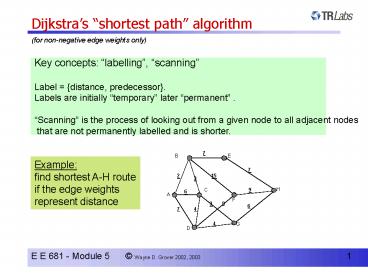Dijkstras shortest path algorithm - PowerPoint PPT Presentation
1 / 9
Title:
Dijkstras shortest path algorithm
Description:
E E 681 - Module 5 Wayne D. Grover 2002, 2003 1 (for non-negative edge weights only) ... E E 681 - Module 5 Wayne D. Grover 2002, 2003 8. Step 7: only node ... – PowerPoint PPT presentation
Number of Views:347
Avg rating:3.0/5.0
Title: Dijkstras shortest path algorithm
1
Dijkstras shortest path algorithm
(for non-negative edge weights only)
Key concepts labelling, scanningLabel
distance, predecessor. Labels are initially
temporary later permanent . Scanning is
the process of looking out from a given node to
all adjacent nodes that are not permanently
labelled and is shorter.
Example find shortest A-H routeif the edge
weights represent distance
2
Dijkstras shortest path algorithm (2)
Start P a vector of permanently labelled
nodes, D a vector of distances - P lt- A -
All other nodes are unlabelled - D lt- all
infinite - source is already perm. labelled
2, A
- Step 1 Scan from node A
- nodes B, C, D get temp labels
- node B gets perm label
- P A, B
- D -, 2
6, A
7, A
3
Dijkstras shortest path algorithm (3)
- Step 2 Scan from node B
- scan goes only to other nodes not yet perm
labelled - node E gets 9, from B
- node F gets 17, from B
- node C gets its label updated 5, from B
- node C is lowest global distance so it gets
the permanent label this time - P A, B, C
- D -, 2, 5
2 7 9, from B
2, A
17, B
6, A
5, B
7, A
4
Dijkstras shortest path algorithm (4)
- Step 3 Scan from node C
- node G gets 8, from C
- node D keeps 7, from A
- node D is lowest global distance amongst temp
labels so it gets the permanent label this
time - P A, B, C, D
- D -, 2, 5, 7
9, B
2, A
17, B
5, B
8, C
7, A
5
Dijkstras shortest path algorithm (5)
- Step 4 Scan from node D
- node F gets updated label 16, from D
- node G keeps 8, from C
- node G is lowest global distance amongst temp
labels so it gets the permanent label this
time - P A, B, C, D, G
- D -, 2, 5, 7, 8
9, B
2, A
16, D
5, B
8, C
7, A
6
Dijkstras shortest path algorithm (6)
- Step 5 Scan from node G
- node H gets label 14, from G
- Since H is also target tempting to stop, but
not yet. - Node E (not just scanned) gets next perm.
Label. - P A, B, C, D, G, E
- D -, 2, 5, 7, 8, 9
9, B
2, A
16, D
5, B
14, G
8, C
7, A
7
Dijkstras shortest path algorithm (7)
- Step 6 Scan from node E
- node H keeps label 14, from G
- node H label permanent now
- P A, B, C, D, G, E, H
- D -, 2, 5, 7, 8, 9, 14
- hence
- A-H shortest route is of distance 14, via H
-gt G -gt C -gt B -gt A
2, A
9, B
16, D
5, B
14, G
If we continue, however, we will get the complete
tree of shortest routes from A to all other
nodes...
8, C
7, A
8
Dijkstras shortest path algorithm (8)
Finally all nodes have permanent labels... the
complete tree of shortest routes from A to all
other nodes has been found...
- Step 7 only node F is not permanently labelled
- scan from H
- Node F label 16, from D is made permanent
- P A, B, C, D, G, E, H, F
- D -, 2, 5, 7, 8, 9, 14, 16
9, B
2, A
16, D
5, B
14, G
8, C
7, A
9
Dijkstras shortest path algorithm (9)
Recap start at source (first perm label) scan
from latest perm label, update temp
labels find lowest temp label make perm loop
till target is perm. label (path only) all
nodes perm (whole tree) Things to remember (1)
Only stop when target node is permanently
labelled. (2) The next node to scan from
may not be one just visited in the last
scan.
At the end, the D, P vectors (plus labels)
encode the shortest path tree































